Redone 2019 Ram moves to top of pickup class
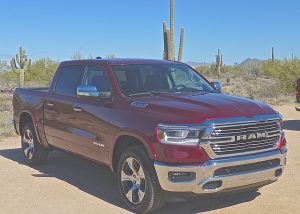
New Ram features dramatic changes from grille to interior, frame, ride, handling, powertrains, and capability for 2019.
SCOTTSDALE, Arizona
If there was any pressure on FCA to come up with a bold, new pickup with the latest generation of the Ram 1500, you couldn’t prove it by the truck itself, or how superbly it performs in any and all conditions. The new Ram is the 2019 model pickup, and maybe that’s appropriate, because if anything it is an advanced look at what a modern, contemporary pickup truck can be.
It’s old news that the largest selling car in the U.S. if a truck — the Ford F-150, and that the second-largest selling car in the U.S. is also a truck — the Chevrolet Silverado. It is less-well-known that the No. 3 best-selling car in the U.S. is also a truck — the Ram, previously the Dodge Ram.
Competition among those three is ferocious, to say the least. And with the newly revised F-150 and upcoming Silverado, there was some pressure on FCA, and Dodge, to recreate their Ram pickup carefully. It is done, now, as a 2019 model, just released for the first introductory drives by auto media on the desert highways and sand washes of Arizona. My partner and I were equally impressed, and we are experienced enough that just naming something new is not going to dazzle us. Mostly, we liked the interior room, and design, and more than anything else we repeatedly raved about how silent the Ram was inside.
The 2019 Ram 1500 half-ton pickup was first shown at the Detroit International Auto Show in January, and it made quite an impression. Dodge has broken various new trails in the pickup world, which is what you do when you’re No. 3 and don’t want to accept that status sitting still.
John Opfer, exterior designer of the new Ram, reminded us that it was back in 1994 that Dodge unveiled its radical new design with the “Big Rig” Ram. To me, it took the somewhat squarish pickup front end and made it look more like a diesel train coming at you, with a massive grille and high, aggressively lunging shoulders for front fenders. That polarizing style, as well as a group of Hemi V8 engines, helped the Ram break into the tight competition between Ford and Chevy.
On the 2019 model, Opfer says, “We have a modern iteration of the Big Rig.”
I don’t think so, although it’s understandable Ram might be reluctant to give up its big, bold trademark image. It seems to me that while Ford and Chevy, and maybe Tundra and Titan, have been getting more and more aggressive in styling perhaps because of the Ram, so the new Ram backs off a bit. Instead of the familiar massive stacked grille, the new one has a refined look with the grille more of a horizontal oval, split by a stylish horizontal bar, which stops in the middle to allow imbedding the letters “RAM.” A nice touch is that fitted right into the small gap at the bottom of the “A” is the forward camera, which works within a system for forward-collision warning, which converts to braking assist if a collision appears imminent.
If the new Ram looks sleeker, don’t believe for a second that it is anything but huge. as Jim Morrison, the head of Ram Brand, explained. “This is the largest truck in the segment, with a 4-inch increase in length,” Morrison said. “That allows us to have a larger interior, which is 3 inches longer in the rear seat alone, which can now recline. Not only is Ram growing, but it also has the highest loyalty rating among pickups. We are attracting new customers, and keeping them.”
Morrison points to significant strengthening of the truck, with 98 percent high-strength steel in the frame, allowing engineers to make the frame stronger and lighter, aided by high-strength steel in the bed, and a light-weight aluminum hood. The seeming contradictory terms of being longer, wider and 200 pounds lighter works amazingly, which you can best experience by driving one. If you haven’t driven a big pickup lately, be prepared. While large pickups can range from $40,000-$90,000, and if that puts them up into the luxury car price bracket, facts now show that a large number of large luxury car buyers are choosing large luxury pickups instead. So demands for luxury features in pickups makes some sense, and the new Ram goes well beyond the boundaries to do exactly that.
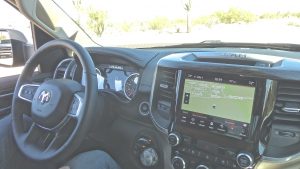
Large, roomy cab with giant nav screen and countless computer, connectivity devices highlight the Ram 1500.
Starting at the bottom, Ram 1500 trucks come in the following models: Tradesman, Bighorn, Rebel, Laramie, Longhorn, and Limited, which makes six different price points. With various packages for engines, cab sizes and shapes, and two bed lengths, the options are almost countless.
We had only the preproduction Rams with the 5.7-liter V8 engine and 8-speed TorqueFlite transmissions, operable via a rotating knob that I still haven’t gotten completely used to. We drove the Laramie and the Bighorn, and we got a chance to thrash the armor-nosed Rebel on an off-road excursion.
On the near horizon is one of the biggest technical breakthroughs in the pickup industry: Ram’s “eTorque” mild hybrid system, which will be available on both the latest 3.6-liter V6 and the 5.7 Hemi V8. It combines a belt-drive electric motor generator with a 48-volt Lithium battery pack to work as a mild hybrid in concert with the engine to allow the start/stop function and to capture energy regeneration via the brakes. In addition, it adds 90 foot-pounds of torque to the V6 and 130 foot-pounds to the V8. That boosts the already potent Hemi V8 up to 395 horsepower and 410 foot-pounds of torque, which helps the Ram get up to maximum towing weight of 12,750 pounds.
Climbing aboard, you are first met by a completely redesigned dashboard, lgauge package, seats, consoles, and steering wheel. There are 151 liters of storage capacity, which, Ram claims, is nearly 100 percent more than its second-best competitor. You can get various size dash screens, depending on models, up to and including am iPad-like 12-inch screen that is fully configurable touchscreen.
If today’s busy on-the-run workers, or families with tech-savvy kids, want more, they can get it in a Ram. The front center console, for example, has 12 different storage compartments, with distinctly designed holders for computers and iPad-type notebooks. In the rear, the seats recline 8 degrees, and also cover under-seat storage bins, some of whuich house wireless charging docks with more connective outlets than any six-occupant vehicle can utilize. The fourth-generation Uconnect service makes available Wi-fi hotspot 4G capability.
A glance at the big nav scren displays a 360-degree surround view with bird’s-eye perspective, and the 3D navigation map can be controlled by spoken destination choices. With all that quiet, incidentally, you can appreciate the huge 900-watt surround sound Harman Kardon amplifier with its 10-inch subwoofer, and noise cancellation, coordinated through 19 speakers. Doesn’t seem that long ago you’d have to use the bed to haul 19 speakers.
In actual driving tests, my partner and I focused more on how the Ram functioned than in all those special features. First off, we noticed how directly it went down the road, with no hint of leaning or wandering, and turning in with quick precision. We attributed all that to the stiffer frame. We also commented to each other frequently about how smoothly the Ram drove, never approaching anything that might resemble harshness. That, of course, is primarily due to the Ram being the only full-sized pickup deploying coil-spring suspension on the rear wheels.
That feature has been out for a few years now, and, typically, Ram engineers have refined and improved it. Along with on-road ride, the coil springs can be combined with air suspension to improve load leveling and fuel efficiency, while also providing some remarkable advantages in off-road driving and trailer towing. For high-tech, the FRD (Frequency Response Damping) shock absorbers are coordinated with the available air suspension for the off-road package, which provides a 1-inch lift, electronic locking rear axle, and the hill-descent control, which is useful for descending steep off-road grades, and also icy steep hills in normal winter driving.
But wait, as they say, there’s more. Something called ATMM, for Active Tuned Mass Modules, combines with Active Noise Cancellation in the cabin to nullify interior noise. Those who have experienced noise-cancelling audio headphones might appreciate how a similar technique can counter vibration and lessen car noise. The 5.7-liter Hemi V8, which also improves its fuel-efficiency with cylinder deactivation, further lowers sound inside the cabin to what Ram engineers say is 66.6 decibels.
The cylinder deactivation can cause an imbalance in engine firing, so Ram engineers said they have designed sensors to pick up any vibration and virtually flip it 180 degrees, cancelling out any vibration.
For added bragging rights, some advanced powertrain technology has a heat-exchanger to heat up a thermal rear axle gear oil system, which gives the rear axle heightened efficiency during cold starts. I may not be a truck guy through and through, but I’ve never imagined being interested in getting my rear axle oil immediately up to operating warmth.
After driving out from The Boulders Resort in Scottsdale, we made our way on various Arizona highways to reach Fort McDowell Adventures, which has all sorts of off-road trails for vehicle or horseback ventures. We didn’t find the off-road challenge very challenging, but we sailed across the deep sand washes with ease, and maybe it was the interior quietness and smooth operation that made us think it wasn’t all that tough.
All of the anticipated safety stuff, such as lane-departure warning and assist, parallel and perpendicular parking aids, and hill-start assist, use ultrasonic sensors to ease the most difficult driving chores, and they coordinate with all the other high-tech items for a real northwoods benefit — the ability to connect your Ram to your boat trailer singlehandedly.
We watched a demonstration where the driver backed up toward the waiting trailer, with its hitch poised and waiting. Shifting the air-suspension to lower the rear of the truck, then engaging the surround overhead view, the driver backed the pickup gently to locate the hitch ball under the hitch. Then he raised the air suspension, climbed out and secured the hitch. Think about it: Waiting inside, listening to satellite radio through more speakers than you can count, and merely checking on the nav screen as you back up and raise the suspension to lift the truck into the hitch. All the time free from industrial-strength Boundary Waters mosquitoes!


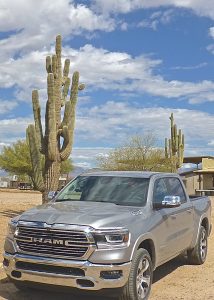
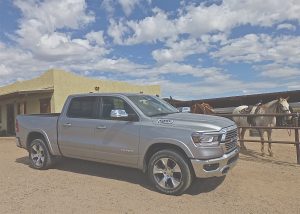
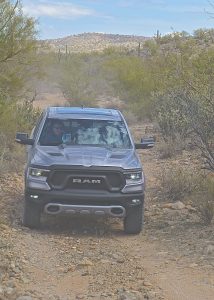
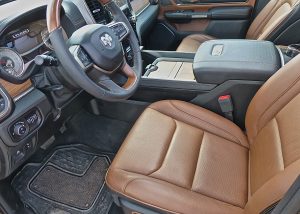
 John Gilbert is a lifetime Minnesotan and career journalist, specializing in cars and sports during and since spending 30 years at the Minneapolis Tribune, now the Star Tribune. More recently, he has continued translating the high-tech world of autos and sharing his passionate insights as a freelance writer/photographer/broadcaster. A member of the prestigious North American Car and Truck of the Year jury since 1993. John can be heard Monday-Friday from 9-11am on 610 KDAL(www.kdal610.com) on the "John Gilbert Show," and writes a column in the Duluth Reader.
John Gilbert is a lifetime Minnesotan and career journalist, specializing in cars and sports during and since spending 30 years at the Minneapolis Tribune, now the Star Tribune. More recently, he has continued translating the high-tech world of autos and sharing his passionate insights as a freelance writer/photographer/broadcaster. A member of the prestigious North American Car and Truck of the Year jury since 1993. John can be heard Monday-Friday from 9-11am on 610 KDAL(www.kdal610.com) on the "John Gilbert Show," and writes a column in the Duluth Reader.